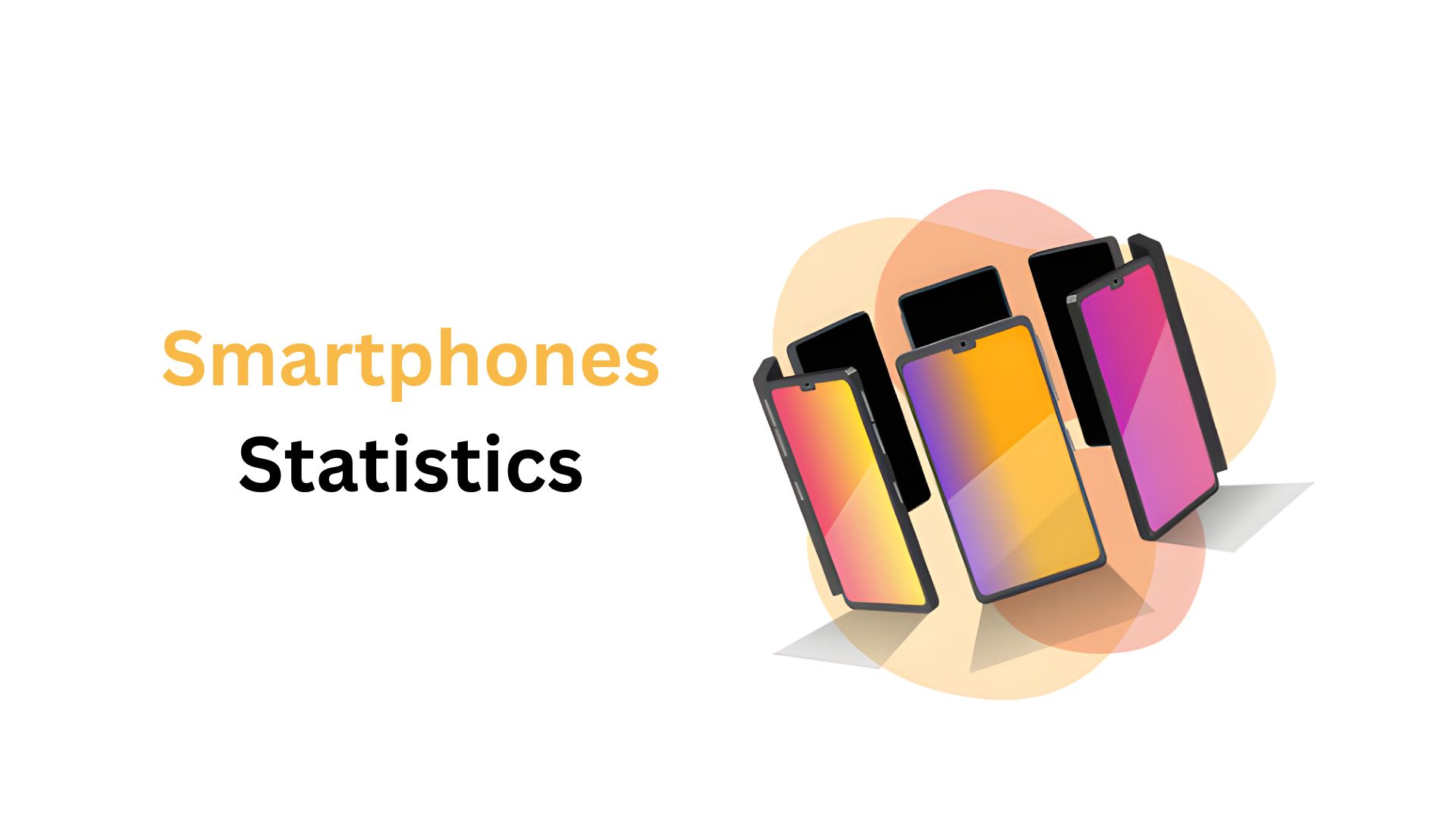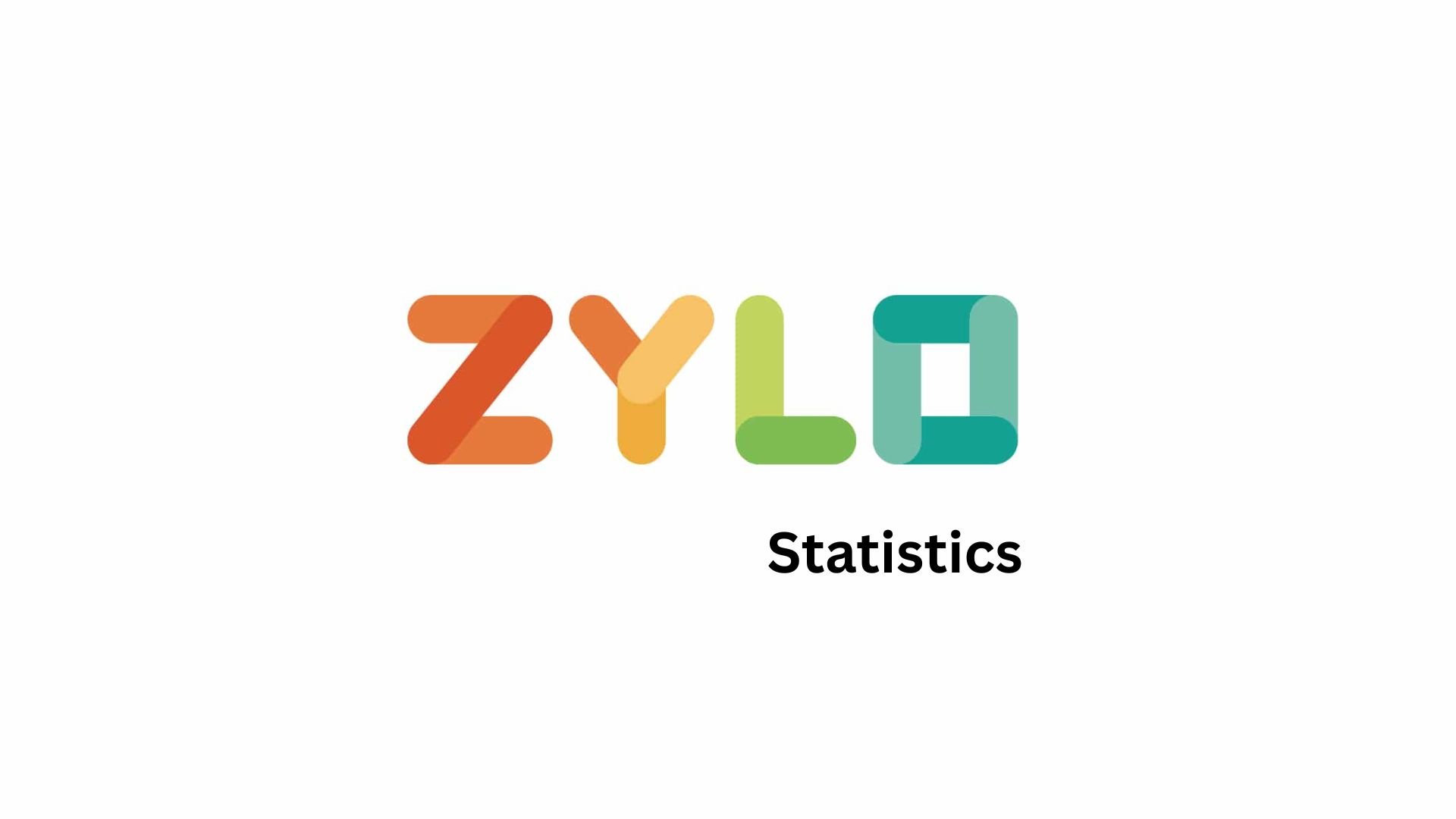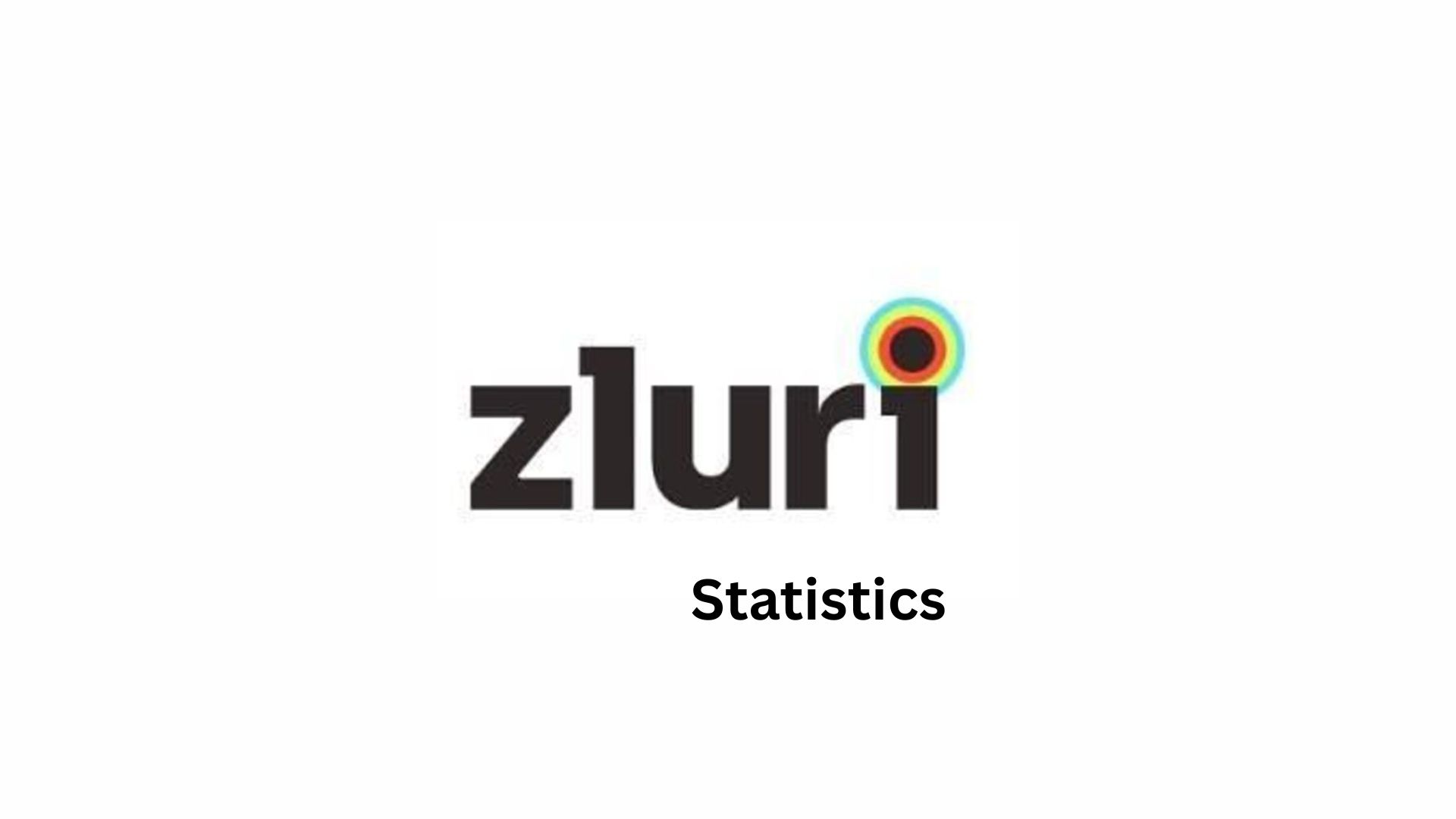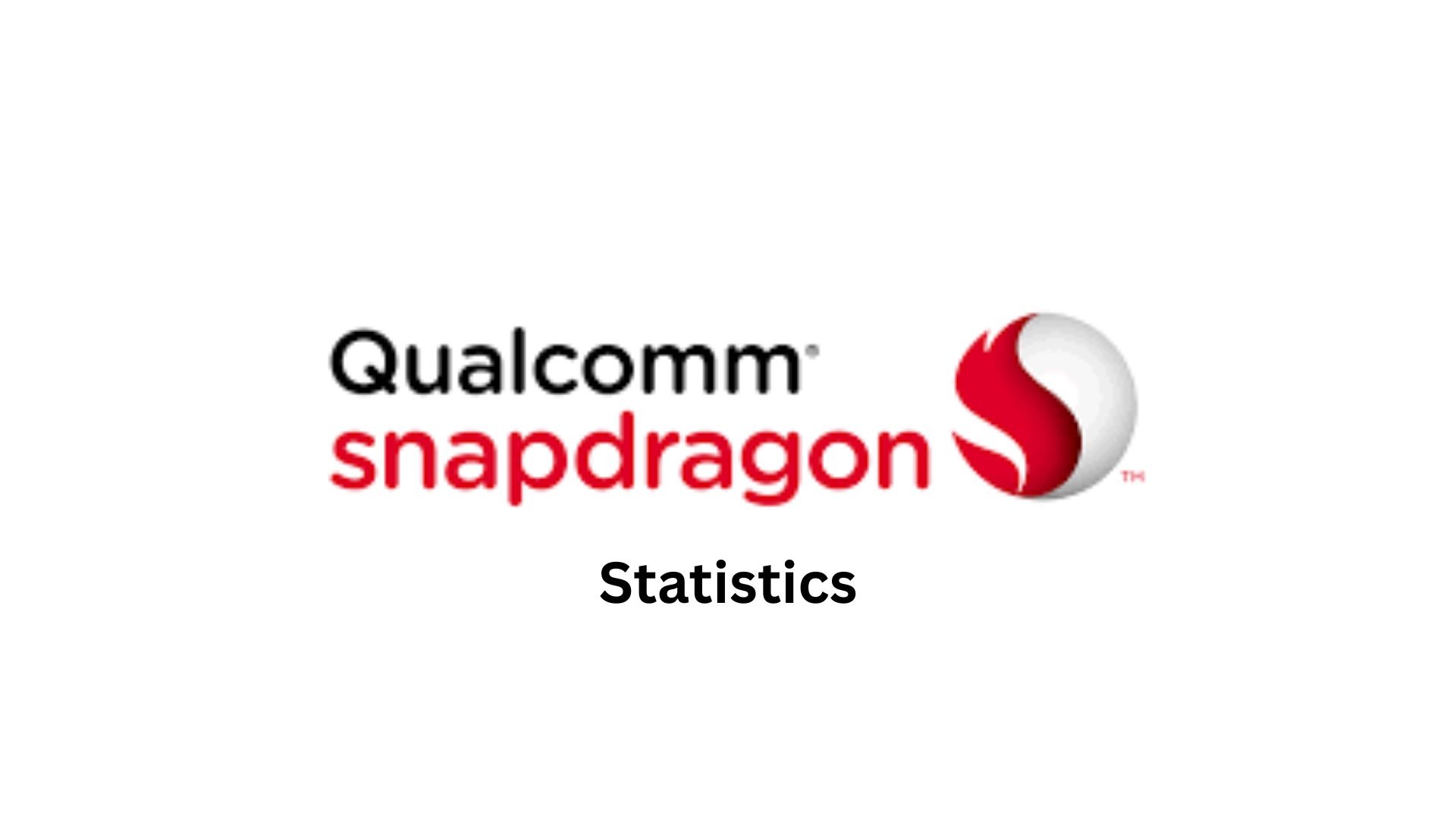How Many Shopify Stores Are There? Statistics And Facts (2025)
Updated · Nov 04, 2025

Table of Contents
- Introduction
- Editor’s Choice
- Shopify Stores Are Active
- Shopify Live Store Distribution By Continent
- Top Countries Shopify Stores
- Shopify Product Category
- Shopify Plus Stores
- Number of Products Sold on Shopify Stores
- B2B vs. B2C Stores on Shopify
- Sales of Shopify Stores
- Shopify App Statistics
- Shopify Statistics and Facts
- Conclusion
Introduction
How Many Shopify Stores Are There? Shopify LLC is, unto itself, an online platform—the largest of its kind in the world. Founded back in 2006 in Canada, it now enables the set-up of online stores by the thousands, ranging from tiny single-product shops to massive global brands.
We will try to find out how many Shopify stores come into existence today, the rate of increase in their number, their geographical locations, what they sell, and the like. As for the numbers stated, these are according to the latest data available in the public domain, with citations as sources.
Editor’s Choice
- There are now about 2.64 million active stores hosted on Shopify as of the third quarter of 2025.
- The United States is the global leader, followed by 38.8% of the total Shopify stores.
- North America presently holds 1.16 million Shopify stores, Europe follows with the next 680,000, and Asia trails behind with 410,000.
- The top product category is Apparel and Accessories, which comprises 21.3% of all stores.
- More than 660,000 stores presently transact with B2B clients, a substantial increase seen in the last two years from 400,000, fueled by Shopify Plus adoption.
- In the U.S., 29,000 stores have been claimed as the hub of Shopify Plus and are by far the majority.
- A considerable share of stores sell fewer than 10 products (26.8%), showcasing a large chunk in the niche selling area.
- The most installed Shopify apps are Product Reviews (531K installs) and Geolocation (523K installs).
- Global eCommerce sales are set to touch US$6.56 trillion in 2025, continuing the upward trend yet slowing growth pace.
Shopify Stores Are Active
- From early 2021 through mid-2025, the number of active Shopify stores has been increasing steadily and consistently.
- The first quarter of 2021 saw about 1.48 million active stores. This figure grew quarter-on-quarter throughout 2021 to beyond 1.65 million by Q4 2021.
- The following year saw a slight drop in Q1, with active stores dipping to approximately 1.64 million.
- The number recovered fast, hitting nearly 1.7 million by Q2 and beyond 1.83 million towards the end of Q3. As 2022 drew to a close, numbers for active stores inched close to 2 million.
| Quarter | Active Stores |
| 2021 Q1 |
1,484,871 |
|
2021 Q2 |
1,570,863 |
| 2021 Q3 |
1,604,305 |
|
2021 Q4 |
1,658,668 |
| 2022 Q1 |
1,646,398 |
|
2022 Q2 |
1,695,519 |
| 2022 Q3 |
1,832,991 |
|
2022 Q4 |
1,988,183 |
| 2023 Q1 |
2,092,927 |
|
2023 Q2 |
2,129,998 |
| 2023 Q3 |
2,212,186 |
|
2023 Q4 |
2,294,041 |
| 2024 Q1 |
2,376,721 |
|
2024 Q2 |
2,380,897 |
| 2024 Q3 |
2,404,674 |
|
2024 Q4 |
2,420,142 |
| 2025 Q1 |
2,527,881 |
|
2025 Q2 |
2,587,750 |
| 2025 Q3 (to date) |
2,643,103 |
(Source: storeleads.app)
- Growth now carries on into 2023, marking over 2.09 million stores in Q1 and about 2.29 million towards Q4. The growth slowed slightly in 2024 but is still positive.
- Active store numbers grew from about 2.38 million in Q1 to around 2.42 million by Q4, suggesting a mature and stable market following years of rapid expansion.
- By 2025, the growth resumed at another accelerated pace. The number of active stores shot up to over 2.52 million in Q1.
- In Q2, it climbed up to 2.59 million. Q3 2025 (to date) reports about 2.64 million active stores on Shopify.
- This may indicate that despite the earlier fluctuations, Shopify has maintained global relevance and is trending upwards.
Shopify Live Store Distribution By Continent
- April 2025 data on Shopify’s global store distribution reveals that North America has the largest number of live Shopify stores, with around 1.16 million stores, 46% of all Shopify stores in the world.
- The major advantage here is the mass adoption of Shopify in the U.S. and Canada, where the platform is headquartered.
- Europe takes the second position with about 680,000 stores, contributing to 27% of the global count.
- Strong platform growth has been observed lately in the UK, Germany, and France, while these nations have seen a surge in e-commerce adoption in recent years.
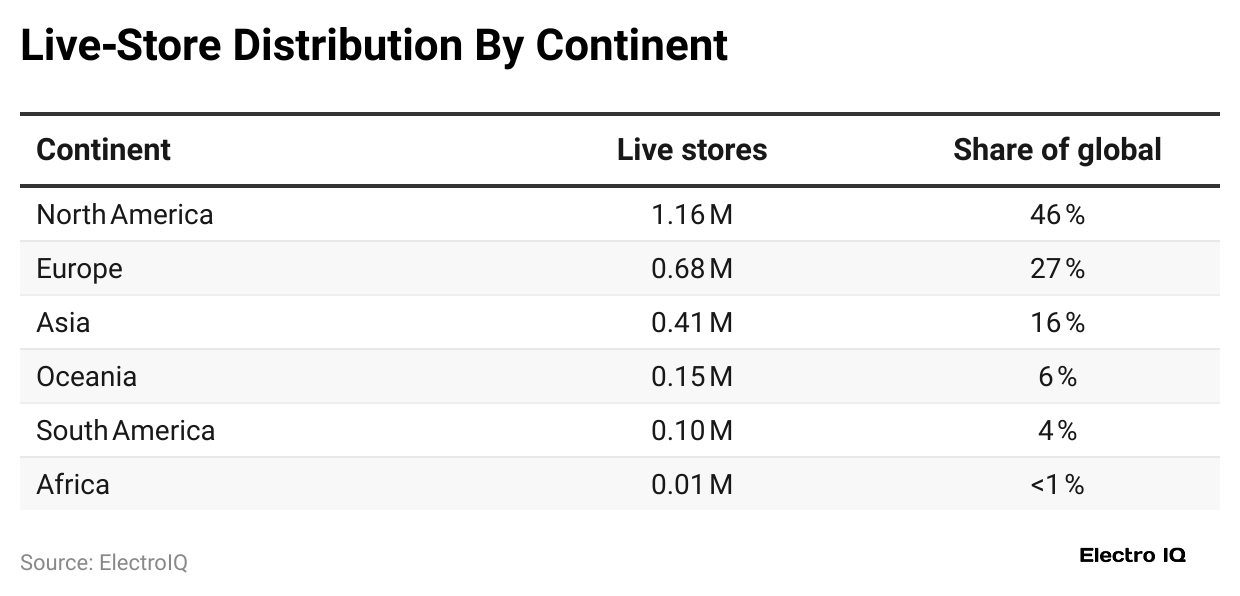
- Asia has some 410,000 stores, constituting 16% of the total.
- While adoption is growing for Shopify in the markets of India and Japan, regional-specific solutions and marketplaces like Shopee or Lazada still compete heavily with the platform.
- Oceania-from Australia and New Zealand-carries about 150,000 live Shopify stores, making up 6% of the whole.
- This is considerable, keeping in mind the comparatively smaller population, suggesting high usage per capita.
- South America has about 100,000 stores (4% of the global share), with Brazil being the main seller for Shopify as it gains weightage in Latin America.
- Africa holds the least weightage, with barely 10,000 live stores, constituting less than 1% of global distribution for Shopify.
Top Countries Shopify Stores
- Shopify maintains a heavy concentration of users in the U.S., whose stores constitute 38.8% of all Shopify stores around the world, making it the largest market for this platform by a large margin.
- The United Kingdom holds the second-largest share, with 7.7% of all Shopify stores. This indicates a massive adoption rate in the UK, where online retail is steadily rising.
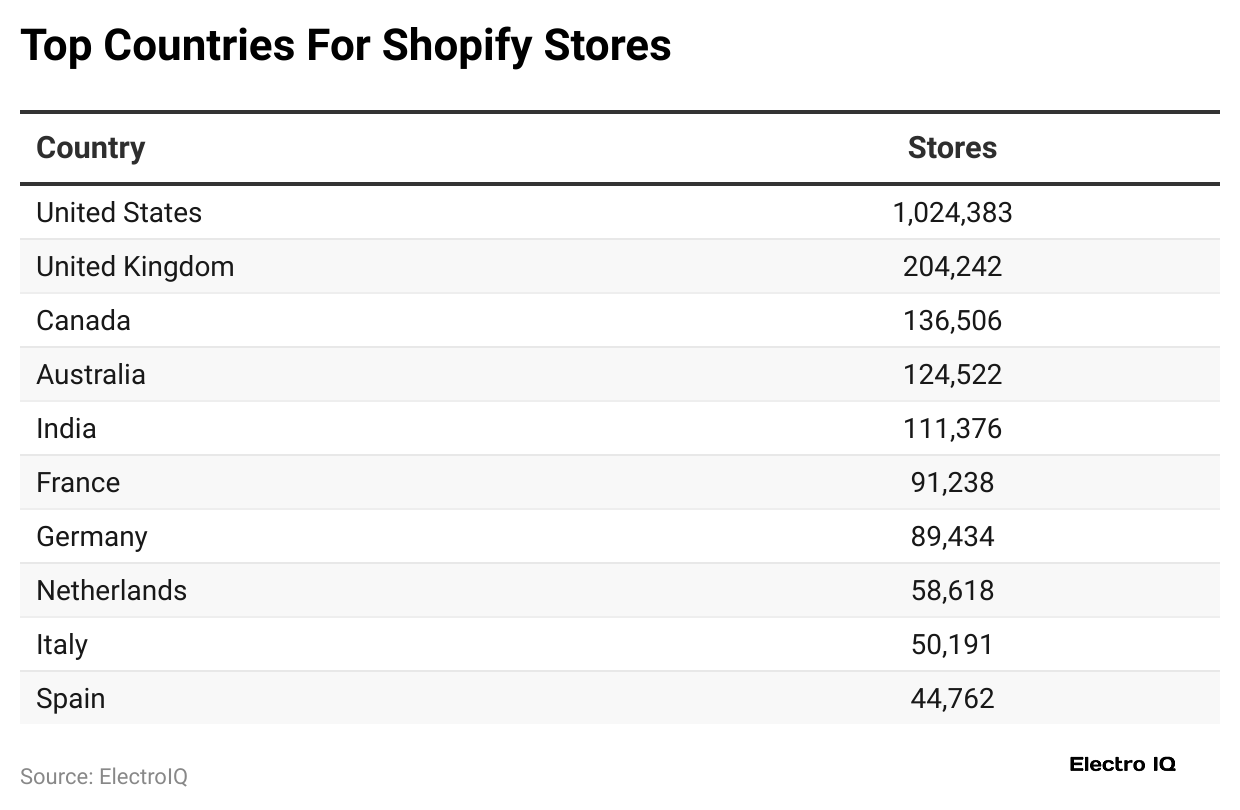
- Canada, being the birthplace of Shopify, holds about 5.2% of shops. Much smaller than the U.S. market, it continues to hold local markets with good growth and local business support.
- Australia comprises around 4.7% of the total, showing a strong presence amid a smaller geographical setup but a highly digital-savvy market.
Shopify Product Category
- The majority of Shopify stores are Apparel and Accessories, with more than 542,000 stores, making up 21.3% of all stores.
- Next comes Home and Garden, with about 235,000 stores (9.2%), followed by Beauty and Fitness (more than 209,000 stores- 8.2%).
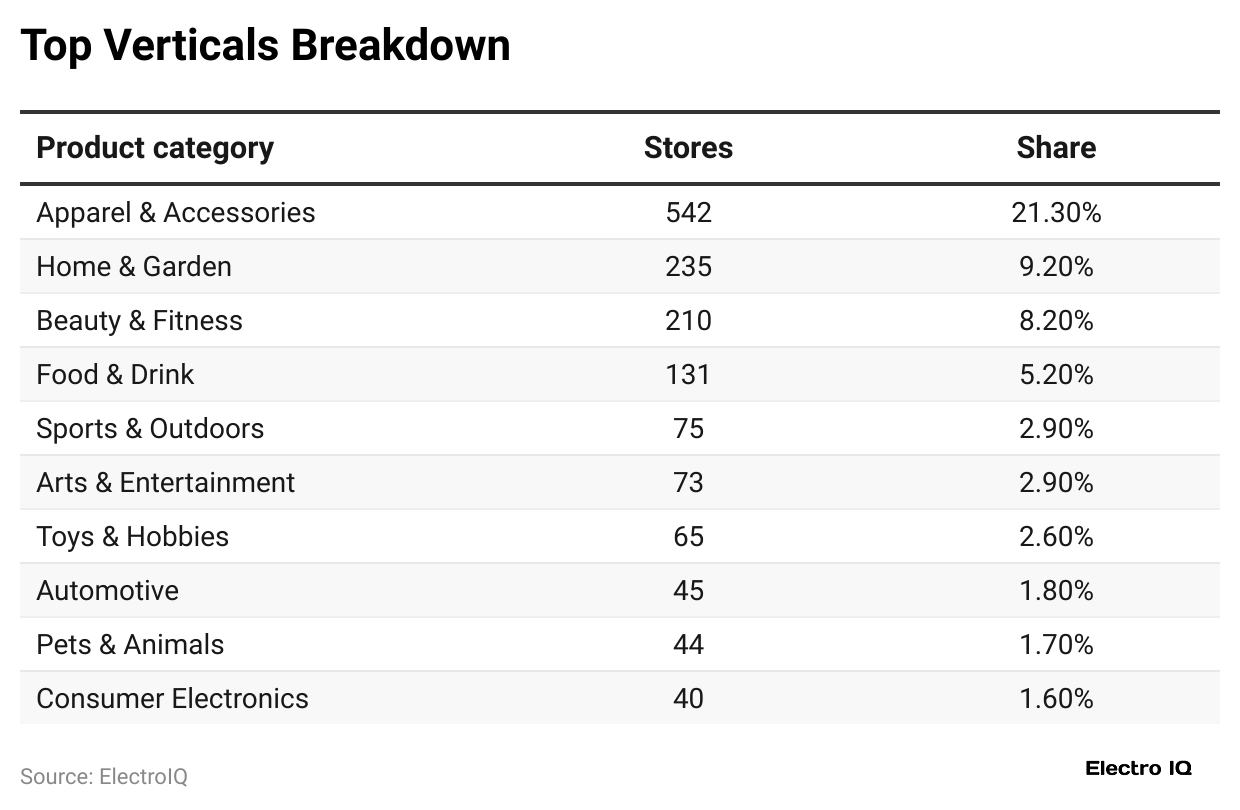
- Food and Drinks are also popular, with 5.2% of stores under that category, while Sports and Outdoors and Arts and Entertainment each make up roughly 2.9%.
- Toys and Hobbies come next at 2.6%, followed by Automotives at 1.8%, Pets and Animals at 1.7%, and Consumer Electronics at 1.6%.
Shopify Plus Stores
- The United States comes out on top by a huge margin, with 29,144 Shopify Plus stores, making it a dominant market for Shopify’s enterprise-level offerings.
- Second is the United Kingdom, with 3,828 stores, representing sturdy adoption but lagging far behind the U.S.
- Australia holds the third place by a close margin with 3,446 stores, with Canada and Germany following, having 3,092 and 1,695 stores.
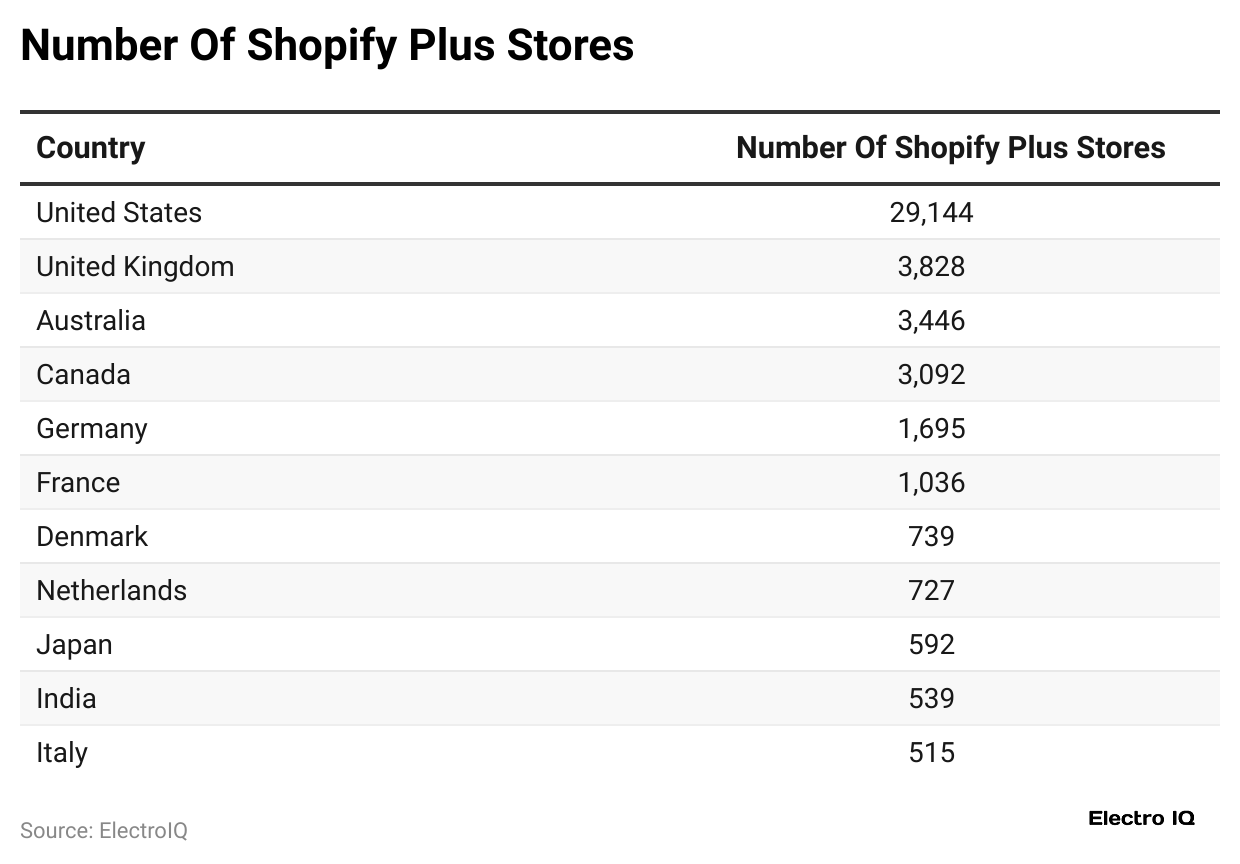
- Some other countries with a respectable number of Shopify Plus stores are France (1,036), Denmark (739), the Netherlands (727), Japan (592), India (539), and Italy (515).
- This reflects the regional distribution of larger and more well-established e-commerce businesses that actively operate on Shopify’s premium platform.
Number of Products Sold on Shopify Stores
- Many Shopify sellers concentrate on a small range of products.
- Around 26.8% of stores sell anywhere from 1 to 9 products, suggesting these stores are very niche or specialised.
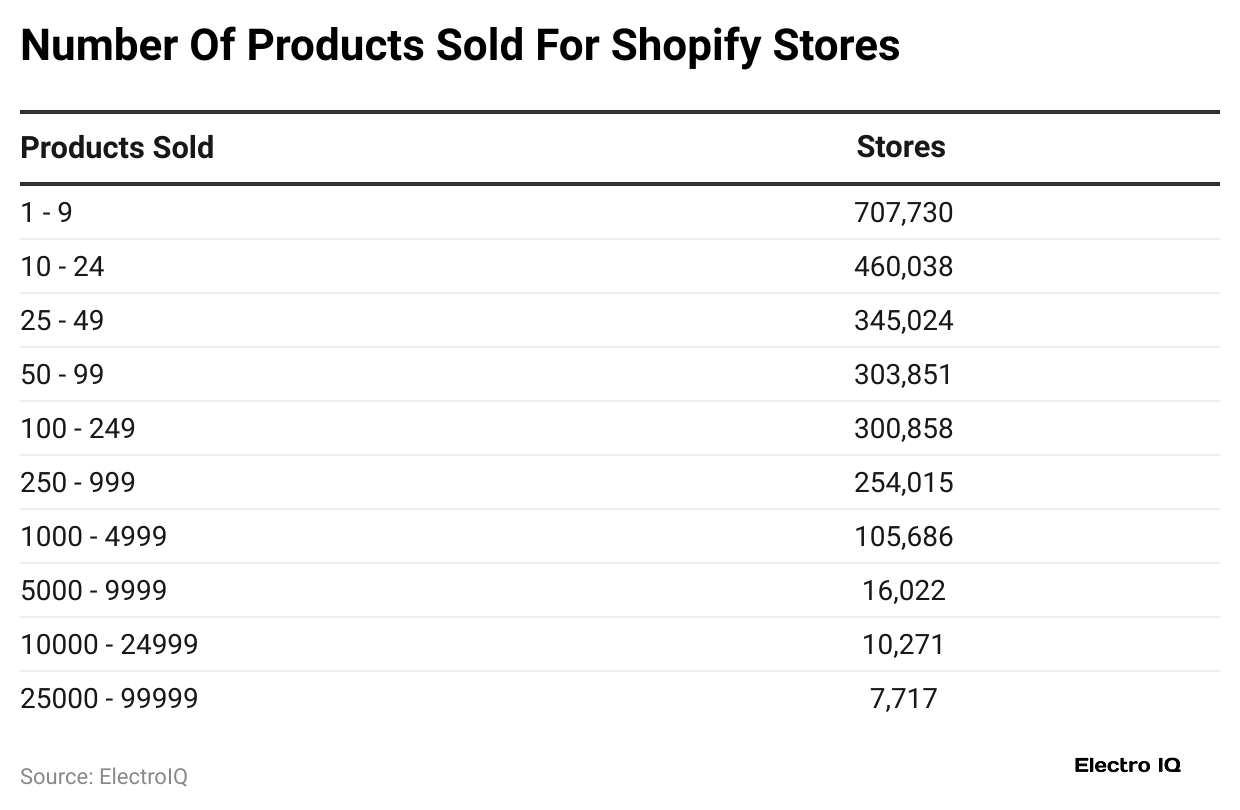
- Another 17.4% of stores have 10-24 products, while 13.1% have up to 25-49.
- This portrays a good number of Shopify sellers working with limited stock, which is far from uncommon for small-scale sellers, startups, or those who cater to dropshipping.
B2B vs. B2C Stores on Shopify
- While Shopify has mostly been fed into used as a platform for B2C stores, recent years have seen the rise of B2B use cases just after the introduction of dedicated B2B tools and enhancements in Shopify Plus.
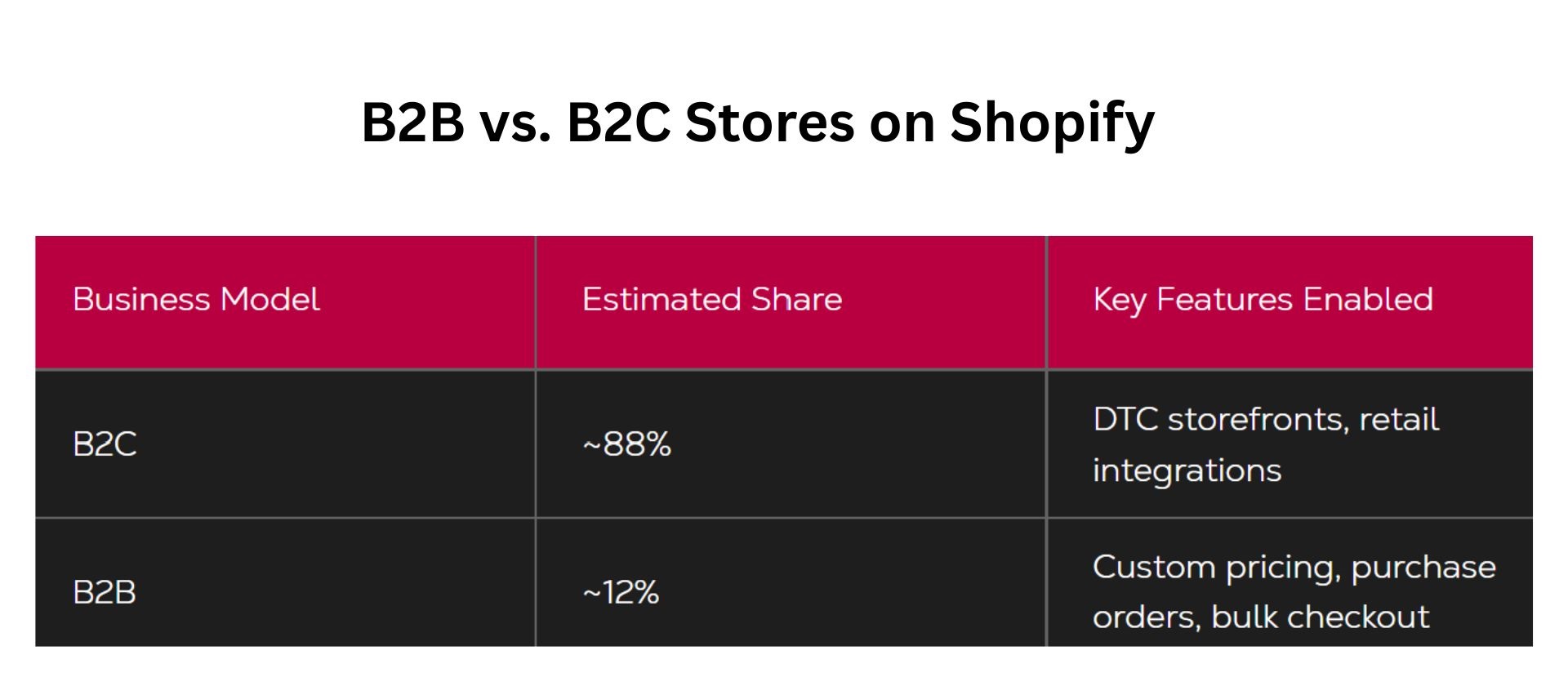
- By the beginning of 2025, over 660,000 Shopify stores had been operating with B2B clients, having more than doubled from some 400,000 stores two years earlier.
- This upward trend emphasises increased demand for wholesale and bulk ordering capabilities.
- Many of these B2B stores will be using Shopify Plus, which supports advanced features, customisations, and integrations demanded by more intricate business processes.
Sales of Shopify Stores
- Global e-commerce sales have been consistently providing steady and consistent expansion for the last few years as a result of the long chain reaction brought upon by online shopping.
- In 2022, total e-commerce sales grossed the magical figure of US$5.13 trillion, up 6.0% from the previous year.
- Another significant rise was recorded in 2023 when sales increased to US$5.62 trillion, settling for a fairly good growth rate of 9.7%.
- This upward movement, however, did not halt through 2024, when sales reached US$6.09 trillion, but here came a slight retardation in the growth pace as it dropped to 8.4%.
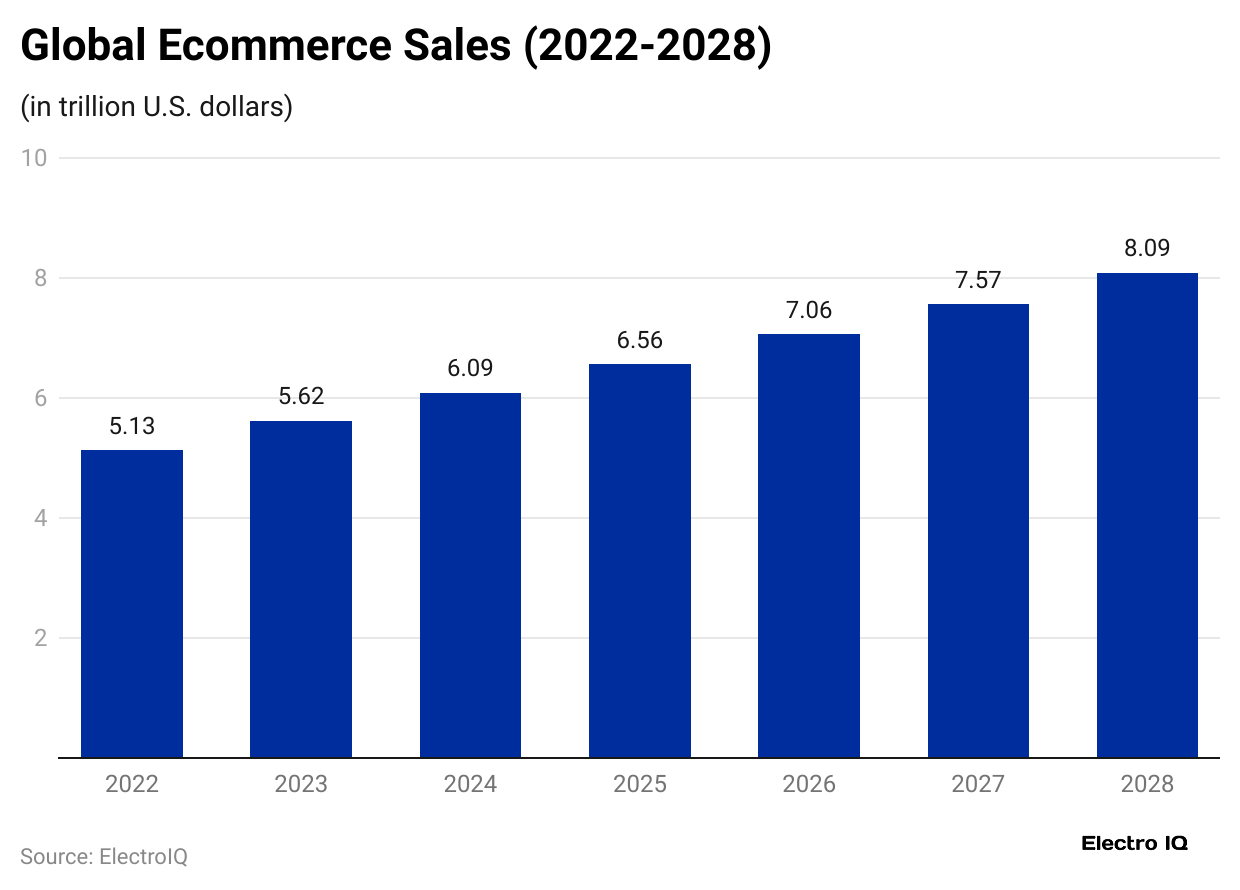
- Global e-commerce performance is expected to reach around the 6.56 trillion mark in 2025, up 7.8%.
- The figure will then ascend to 7.06 trillion in 2026, with a 7.5% growth rate, and 7.57 trillion in 2027, with a rate of 7.2%.
- The number is anticipated to clock over 8 trillion in sales in 2028 at 6.9%.
- This steady growth is powered by an increase in technology and internet penetration, as well as changing consumer behaviours.
- These statistics show the pattern on an aggregate level, establishing itself as a platform on which digital commerce sustains its growth.
Shopify App Statistics
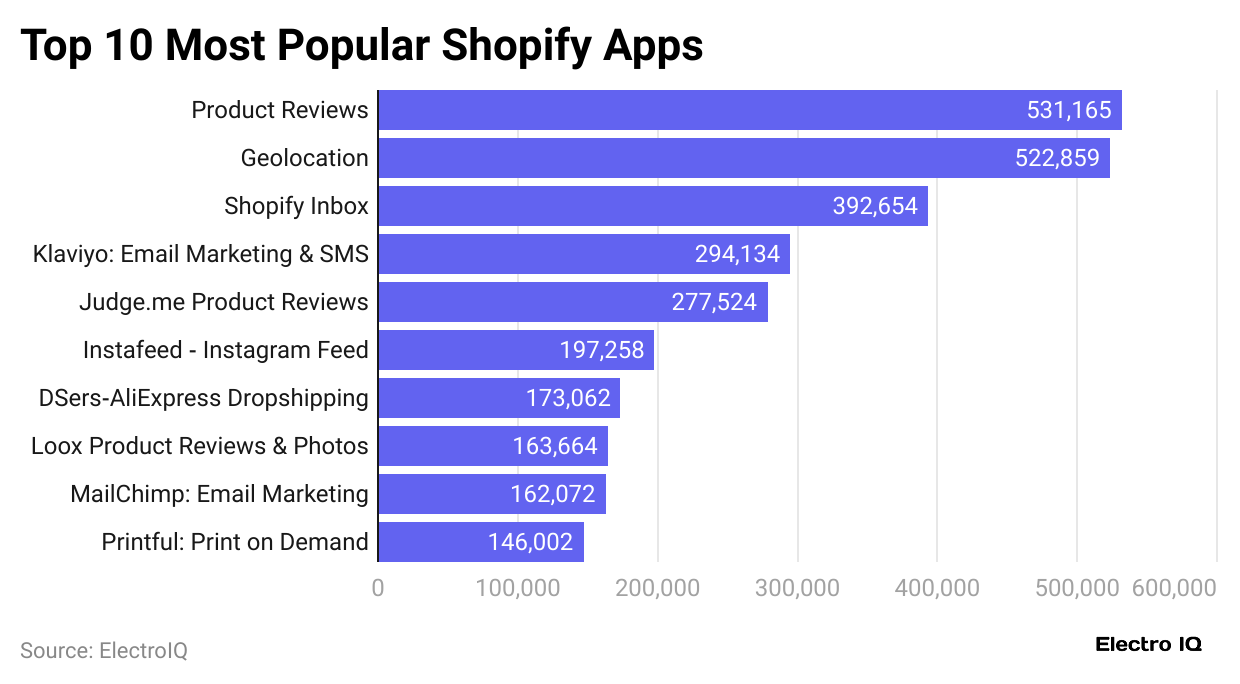
- Close behind are about 522,859 downloads of the Geolocation app that allows businesses to change their website content and currency depending on the visitor’s location.
- Shopify Inbox has 392,654 installations; this app is most widely adopted by merchants desirous of communicating with their customers on different messaging platforms.
- Klaviyo: Email Marketing & SMS, with its 294,134 installations, is another increasingly popular app, which stands for the modern-day reliance on email and SMS campaigns to engage customers.
- me Product Reviews is one of the tested tools for customer feedback, with 277,524 installations.
- Instafeed–Instagram Feed is a good representative for social integrations with 197,218 installations, allowing merchants to bring their Instagram content directly onto their storefronts.
- Being the most installed dropshipping app with 173,062 installations, DSers–AliExpress Dropshipping establishes its presence as the most capable app for streamlining product sourcing from AliExpress.
- Loox Product Reviews & Photos is also popular among merchants for providing them with the ability to show their customers’ visual feedback, with 163,664 installs.
- MailChimp installation still hits the charts for email marketing automation with 162,072 installations.
Shopify Statistics and Facts
- Shopify had revenue of USUS$205 million in 2015, which had grown to US$7.06 billion by 2023.
- As of Q3 2024, Shopify has generated revenue of US$6.02 billion already in 2024 and is expected to break previous records set for the year.
- With a 27% share, Shopify is the biggest player in the global e-commerce platform market.
- There are said to be 5.46 million users on Shopify in 2024, which is quite a hike from 41,000 in 2012.
- The market price for Shopify exhibits an average figure of US$106.78, whilst the market capitalisation is US$84.15 billion.
- From a traffic standpoint, mobile traffic stands at 40.3%, while desktop traffic runs at 49.7%, with tablet traffic being 10%.
- Geolocation, with over 522,859 downloads, allows users to customise content based on location.
- DSers-AliExpress Dropshipping is the first dropshipping app with 173,062 installs.
- Loox Product Reviews & Photos and MailChimp have over 160K installs each, showing that the importance of email marketing and customer visibility still has to be established.
- Shopify’s competitors are WooCommerce, hosting 6.1 million websites, and Squarespace, controlling 5.4 million, for e-commerce.
- In 2024, Shopify left both Wix (20%) and WooCommerce (17%) behind when it came to market share.
Conclusion
By a simpler explanation, as of spring 2025, Shopify is said to power approximately 2.64 million live store domains worldwide. Although the platform is growing, growth has slowed from the pandemic highs, yet still, Shopify manages to build new boutiques, amounting to hundreds of thousands per annum. Shopify has a footprint on all continents, the most popular verticals being clothing and accessories, and one-third of the stores sell less than ten products, indicating a large number of small-scale or niche operations.
Shopify Plus supports tens of thousands of enterprise-level merchants. These facts broadcast back to the prominence of Shopify: presently, it has millions of merchants, moves one-fourth of a trillion dollars in merchandise on an annual basis, and still stands tall as a central force in global e-commerce.
FAQ.
Nearer to the third quarter of 2025, there will be approximately 2.64 million active Shopify stores around the world. There has been continuous growth from previous years, with acceleration in 2025 after a lull in 2024. Hence, the said platform remains amongst the top destinations for online merchants globally.
While the U.S. is home to some 38.8% of all Shopify stores, next come the U.K. (7.7%), Canada (5.2%), and Australia (4.7%). These four, put together, account for a great deal of the total number of stores on the platform, pointing, therefore, to great e-commerce infrastructure and acceptance in these regions.
Apparel and Accessories top the chart, housing 542,000+ stores (21.3%). Other significant product classes are Home and Garden (9.2%), Beauty and Fitness (8.2%), and Food and Drink (5.2%). Shopify’s strength lies in lifestyle, fashion, and wellness.
Over 660,000 stores now serve B2B customers, growing from 400,000 two years ago, largely due to Shopify Plus adoption. With over 29,000 stores, the U.S. leads in Shopify Plus adoption, followed by the U.K., Australia, and Canada.
Product Reviews lead with over 531K installs, followed by Geolocation (523K) and Shopify Inbox (392K). Other well-known apps are Klaviyo for email marketing, Judge.me, DSers for dropshipping, and Printful for print-on-demand.

Tajammul Pangarkar is the co-founder of a PR firm and the Chief Technology Officer at Prudour Research Firm. With a Bachelor of Engineering in Information Technology from Shivaji University, Tajammul brings over ten years of expertise in digital marketing to his roles. He excels at gathering and analyzing data, producing detailed statistics on various trending topics that help shape industry perspectives. Tajammul's deep-seated experience in mobile technology and industry research often shines through in his insightful analyses. He is keen on decoding tech trends, examining mobile applications, and enhancing general tech awareness. His writings frequently appear in numerous industry-specific magazines and forums, where he shares his knowledge and insights. When he's not immersed in technology, Tajammul enjoys playing table tennis. This hobby provides him with a refreshing break and allows him to engage in something he loves outside of his professional life. Whether he's analyzing data or serving a fast ball, Tajammul demonstrates dedication and passion in every endeavor.


